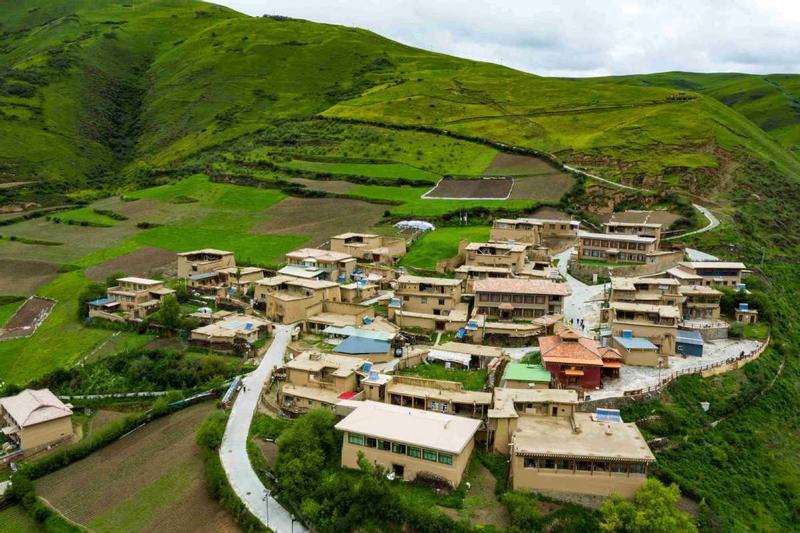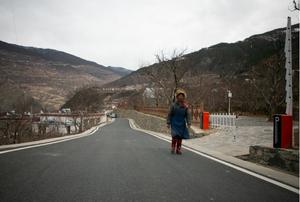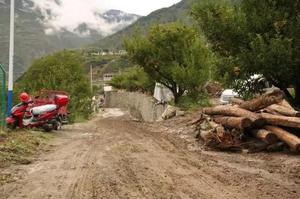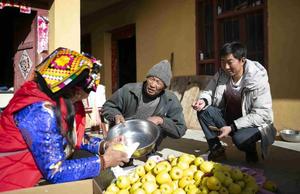In a remote Sichuan province prefecture, villagers have been lifted out of poverty by improvements to transport infrastructure. Zhang Wenfang reports from Aba.
 An aerial view of a village, surrounded by mountains, in the Aba Tibetan and Qiang autonomous prefecture, Sichuan province, in June. Many homestays with Tibetan features were built in the village to boost tourism and lift locals out of poverty. (SHEN BOHAN / XINHUA)
An aerial view of a village, surrounded by mountains, in the Aba Tibetan and Qiang autonomous prefecture, Sichuan province, in June. Many homestays with Tibetan features were built in the village to boost tourism and lift locals out of poverty. (SHEN BOHAN / XINHUA)
As dawn broke on the western plateau in Sichuan province, Sanga and his family began to milk yaks that had been roaming in an alpine meadow.
Before the blazing sun hit its peak at noon, the herder, in his 50s, had returned home in his van with nearly 300 yuan (US$42) after selling 20 liters of fresh yak milk in Nandamu township 30 kilometers away.
Two years ago, it would have taken him the entire day to make the round trip and the yak milk would have fetched less money.
Sanga lives in Wukeji village, Shangduke township, in Zamtang county of the Aba Tibetan and Qiang autonomous prefecture. Nandamu township is the nearest and most important market town for the herders.
Shangduke is set in alpine meadows, while Nandamu is located at the foot of a mountain. For years, the only access between the two townships was via a narrow meandering path.
When the herders wanted to sell their yak milk, meat and butter, they had to travel on horseback along a mountain trail, or make a 70 km detour traveling on an asphalt road through Zamtang county.
"It took me five to six hours ride by horse to reach the town to sell milk. The price was 4 yuan for a half liter," said Sanga, who goes by only one name.
"Cheap prices were offered to us because the buyers knew that we had come a long way and if we didn't sell the milk, we wouldn't find any other buyers in time. The milk could go off and we might not make anything."
In October and September, the herders also drove yaks down the mountain to sell at market, which was a day's journey, Sanga said. Money had to be spent on accommodation and fodder if the herders had to wait for buyers, he said.
 A villager walks on an asphalt road in Xiaojin county, Aba, Sichuan, in January. (LI MENGXIN / XINHUA)
A villager walks on an asphalt road in Xiaojin county, Aba, Sichuan, in January. (LI MENGXIN / XINHUA)
Headed to market
However, travel between the two townships became much easier when a 34-km paved road was completed last month.
The winding road drops from an altitude of 4,200 meters to 3,500 meters and connects 2,300 herders living in three villages to the trading township below.
"The travel time has been cut to a 30-minute drive by van," said He Dongming, deputy director of the transport bureau of the county."The milk is fresher when transported down the hill, so the sale price for milk has increased from 4 yuan to 7 yuan for a half liter."
He said it was no longer a buyer's market and if the herders were unhappy about prices offered for their products they could simply take them back home. The herders can also travel to other townships in the county to seek better prices for their products and customers can drive up the mountain and buy produce and goods directly.
"The passive role of our herdsmen has completely changed," He said.
With an investment of 50 million yuan, road construction began in 2018 as part of the Ministry of Transport's poverty eradication plan aimed at improving infrastructure in Zamtang county.
Since 2009, the Ministry of Transport has invested 2.14 billion yuan in targeted poverty relief efforts for the prefecture's Xiaojin, Zamtang and Heishui counties, and Sertar county in the Garze Tibetan autonomous prefecture, building 127 roads covering 1,440 km.
 The dirt road in Xiaojin last year before the improvements to road infrastructure. (LI MENGXIN / XINHUA)
The dirt road in Xiaojin last year before the improvements to road infrastructure. (LI MENGXIN / XINHUA)
Fruits of success
Road infrastructure problems had for years hindered fruit farmers from Mulan village, Xiaojin county, from accessing wider markets.
Green apples from the county are prized for their acidity and a red blush on the skin. With a cultivation area of 80 hectares, Mulan village is a major apple production region in the county.
Last year, about 400 households in the village harvested 5,000 metric tons of green apples, generating revenue of over 7 million yuan.
But in 2015, it was a totally different picture.
Back then, a national highway passed by the village but there was no connecting road, leaving Mulan village isolated on the mountainside.
Fruit growers had to carry baskets of apples down slopes on their backs and hawk them on the highway to passing motorists.
Some growers made the extra effort to take their apples to a wholesale market in the provincial capital Chengdu, more than 300 km away. The one-way journey took seven to eight hours. Many of the apples spoiled on the way and the wholesale price was 0.6 yuan per 500 grams.
Before 2015, the village's total revenue from apple sales was below 2 million yuan. Due to weak demand, a large quantity of apples was left to rot in the fields.
Villagers lost confidence in their ability to earn a living from the fruit and orchards were left untended.
In 2015, to boost the apple industry, the village paths were surfaced and a road to the highway began construction. Four years later, a total of 3.5 km of asphalt road was extended into the village.
Since then, the Mulan green apple has earned a good reputation and generated strong sales. Fruit retailers drive trucks into the village and purchase the green apples for a wholesale price of 1.5 yuan per 500 grams.
In 2017, Mulan village welcomed its first delivery depot, which encouraged the growers to sell their apples nationwide on online platforms such as WeChat and Taobao.
"I meet a lot of consumers from Zhejiang province on WeChat and they like my apples very much," said Long Huagui, 50, a farmer from the village.
"All I need to do is to pack the apples at the depot and the rest is in the hands of the delivery business. It takes three days at most for the apples to reach customers' homes."
The retail price varies from 3 to 5 yuan per 500 grams and about 15 percent of the output is sold online.
Long said selling apples is no longer difficult, and before they have come into season he starts receiving orders.
Fruit growing has developed into a multi-billion-yuan industry in the prefecture and has helped increase farmers' income and relieve poverty. Last year, the prefecture's cultivation area for apples, pears, cherries, plums and other fruit reached 18,032 hectares while output topped 211,400 tons.
 Local residents sell apples via livestreams in Xiaojin in January. (LI MENGXIN / XINHUA)
Local residents sell apples via livestreams in Xiaojin in January. (LI MENGXIN / XINHUA)
Tourism boom
Surfaced roads have now reached all administrative villages in the Aba Tibetan and Qiang autonomous prefecture. Of 14,001 km of roads in the prefecture, 9,788 km are rural ones.
The new road network has not only helped local products find bigger markets, but it has also brought in more visitors and boosted tourism.
"A family suite has been reserved for you. Would you like any other services?" Chungla, 31, a homestay operator on the Hongyuan prairie recently asked a guest over the phone.
As the COVID-19 epidemic has been brought under effective control, Chungla has received more booking enquiries since May. "Our business in the first half of this year was badly affected by the epidemic," said Chungla, who uses one name.
Her family inns are adjacent to a highway traversing the vast grassland of Hongyuan county. After 2015, when the road was opened, she expanded her homestay business as the number of self-driving travelers increased rapidly.
"Originally, my parents ran a small stud farm with four horses and 10 yurts. I was 9 and often helped by leading the horses for guests," Chungla said.
"They paid 2 to 20 yuan for a horse ride and 20 to 50 yuan to spend a night in the yurt. There were no beds and they would sleep on the ground."
Chungla later took over the running of the business, but admits it didn't change much, with the exception of charging more for horse rides.
However, in 2015 the business took off thanks to the highway and an increase in visitor numbers. The existing facilities couldn't keep up with demand and Chungla decided to expand her facilities.
Seven wooden houses and five brick ones equipped with modern appliances were built to replace the yurts.
"Now we have standard rooms and family rooms with 37 beds in total. Pricing for each house also differs, varying from 130 to 400 yuan per night," she said.
Chungla, who runs the business with her younger brother, is aware of the unusual challenges the location presents for visitors due to the altitude. When they receive guests, they inform them where the humidifier is in the room, to use if the air is too dry, and how to use oxygen bottles or bags if they have altitude sickness.
Besides horse riding, more recreational activities have been added such as outdoor barbecues, campfire parties and special Tibetan meals. Visitors come from all over the country and even overseas.
"After 2015, I have made 300,000 yuan on average every year," Chungla said. "Earlier on, my family was the only one doing the homestay business. Now homestays have mushroomed thanks to the road."
Rolling on
Last year, 1.5 million trips were made to rural and pastoral areas in the prefecture, generating a healthy income of 7.78 billion yuan.
The prefecture is dominated by a plateau, mountains and gorges with an average altitude of over 3,000 meters. While posing major challenges to transportation routes, the terrain and climate have created natural topographical wonders as well as rare plant and animal life.
Of the prefecture's 900,000 residents, people of ethnic groups account for over 80 percent and Tibetan people nearly 60 percent of the total.
"Roads are of extreme importance to our people's lives and the development of rural and pastoral areas," said Li Bin, deputy director of the prefecture's transport bureau.
"In the past, after they traveled, their clothes were covered in dust and dirt on dry days and mud on rainy days."
Li said farm produce often got "stuck in the fields" due to a lack of transportation, making life difficult for villagers who relied on one source of income.
"With roads built almost to their doorsteps, they can get on the bus immediately after walking out of their homes," Li said. "Trucks drive directly to the fields and produce picked up in the morning in villages appears on city dinner tables that night."
By the end of last year, road surfacing work in 606 poverty-stricken villages in the prefecture had been completed, with a cumulative length of 4,568 km. As of February, all 13 counties and cities in the prefecture had been lifted out of poverty.
Despite this, efforts to improve road infrastructure in the prefecture continue. Investment in transport infrastructure has exceeded 13 billion yuan for two years in a row and is projected to reach 20 billion yuan this year.
By 2025, the total length of roads is expected to reach 15,000 km, with rural roads remaining the focus.
Contact the writer at zhangwenfang@chinadaily.com.cn


